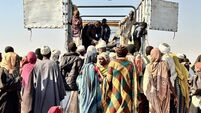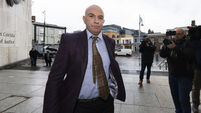Democracy pledge fails to win round protestors
A visibly uncomfortable king promised to restore democracy in Nepal, in a bid to end a bloody political crisis that has engulfed the Himalayan nation.
But the efforts of King Gyanendra were met with an opposition pledge of more demonstrations.
With well over 100,000 protesters filling the streets and a top envoy warning the government could be nearing collapse, Gyanendra’s promises showed little sign of mollifying the political opposition – or a public desperate for change 14 months after he seized power.
The king, though, insisted in his speech he was acting on behalf of the nation his family has ruled since the 18th century.
His dynasty, he said, had an “unflinching commitment toward constitutional monarchy and multiparty democracy”, and he called on the seven main opposition political parties to quickly name a prime minister.
“Executive power … shall, from this day, be returned to the people,” he said in the announcement broadcast on state television and radio.
Gyanendra, never an electric public speaker, looked particularly uncomfortable during yesterday’s speech, frozen rigidly in front of a cloth backdrop and staring directly into the camera.
His glumness is unsurprising. In a country where kings were revered as godlike just a few years ago, Gyanendra is deeply unpopular, isolated in a collection of palaces and has lost control of much of the countryside to Maoists seeking to create a communist Nepal in an uprising that has killed nearly 13,000 people.
Observers fear the country could, at worst, descend into chaos, creating a power vacuum into which the Maoists, with their long history of violence, could step in.
In addition, many demonstrators are increasingly demanding that he give up all his power – something the king is clearly unwilling to do.
Yesterday, the US State Department urged the king to follow up his promise to restore democracy to the country of 27 million people, once famed for its spectacular mountain ranges and hippy tourists in search of Eastern spirituality - but now known for its chaotic, bloody politics.
“The people of Nepal deserve a democratic government that can return stability and peace to their country,” spokesman Sean McCormack said.
Opposition leaders saw little in the speech to resolve the crisis, which began when the king seized power in February 2005, saying he needed to crush the Maoist uprising.
“This is incomplete,” said Minendra Risal of the Nepali Congress Democratic Party, one of the seven opposition parties that have joined with the Maoists to protest the king’s seizure of power last year.
The king, he noted, fell short of a key opposition demand – the return of parliament and creation of a special assembly to write a constitution. The constitutional assembly “is the aspiration of the people”.
Most opposition leaders want a constitution that would make the king a ceremonial figure or eliminate the monarchy entirely.
But they saw other problems too: Under the new plan, the king would retain an undefined political role in a constitutional monarchy and apparently keep control of the military.
“This looks like another attempt by the king to fool the people,” said Subash Nemwang of the Communist Party of Nepal. “It is a desperate attempt to save the regime.”
In the streets, the reaction was angrier.
On the outskirts of Kathmandu, scene of the most violent protests, many said Gyanendra could not be trusted.
Other demonstrators voiced cautious optimism. “We have won the battle, but we still must win the war,” said Grihendra Shrestha.
Nepal’s crisis has escalated since a general strike called by the parties and the Maoists began two weeks ago. Protesters have filled the streets daily, leaving the country paralysed, stores emptied of goods and the situation dangerously volatile. Security forces firing at protesters have killed at least 14, and wounded many more.
Yesterday, the co-ordinating body of the seven-party alliance issued a short statement, although it was unclear whether it was a direct reaction to the speech. “The general strike and other protests will further intensify,” it said.
At least a half-dozen protests broke out in and around Kathmandu, all in defiance of a curfew. In the largest, more than 150,000 protesters filled the streets on the outskirts of the city.
The Maoists remain a major unknown. Although they have recently allied themselves with the political parties, their violent history worries even their allies.
When Gyanendra claimed direct control over the government 14 months ago, he argued that he had to bring order to a corrupt political scene and end the communist uprising.
While many initially welcomed the king’s move, hoping he would bring stability, his popularity waned badly as the uprising worsened and the economy faltered.
“It’s not enough for us. We are demanding a new constitution with a presidential system – a republic,” Prakash Thapa, a teacher, said after the king’s speech. “This country does not need Gyanendra, the thief.”













